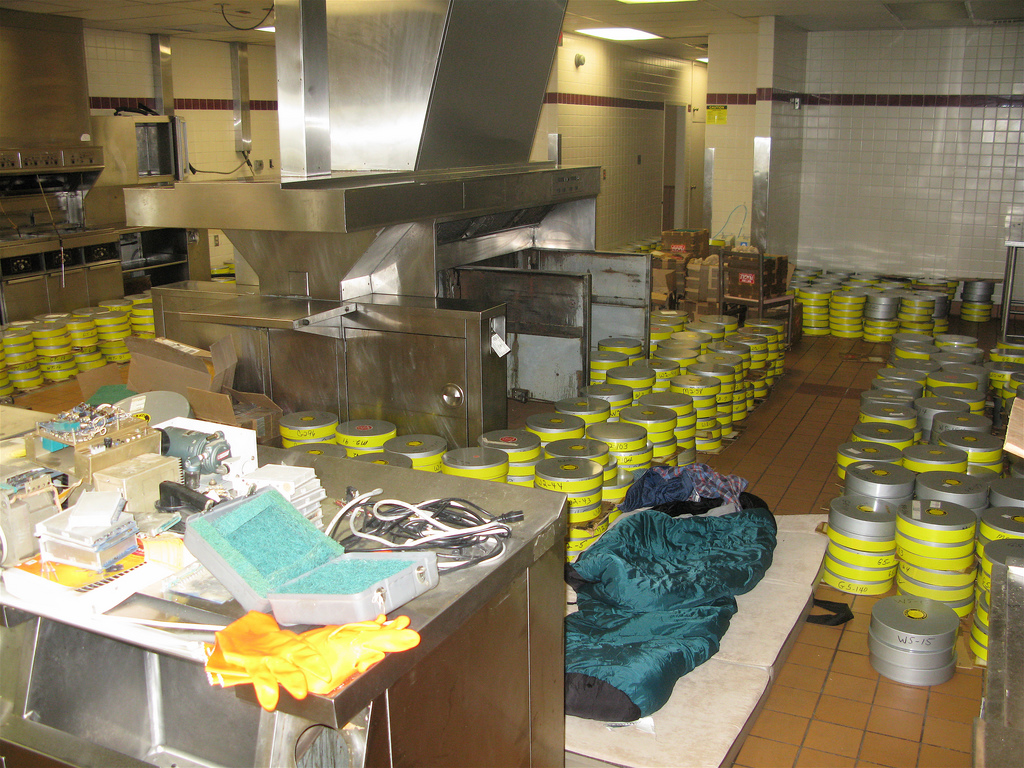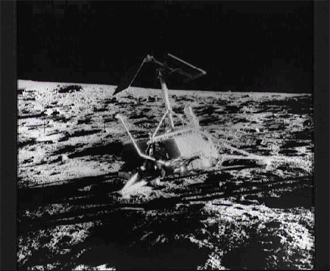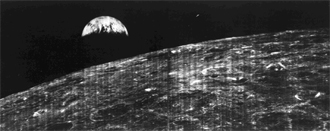|
|
|
|
Part Two ..
Why We ExploreVoyages
to the Moon: Robotic Reconnaissance
05.01.06
NASA Source Article 
Editor's Note: This is the 19th in a series of essays on exploration by NASA's Chief Historian, Steven J. Dick. It is hardly cause for surprise that with the beginning of the Space Age humans set their sights on the nearest celestial body, the Moon. Source of nighttime light, an object of poetry, romance, mythology and even veneration from the dawn of civilization, it eventually also became an object of scientific scrutiny. It was long known to eclipse the Sun, and to be eclipsed itself. It was later found to be about 2,000 miles in diameter, one-quarter the diameter of the Earth. Nevertheless it is surprising how little was known about the Moon before the Space Age began. Astronomers had trained their most powerful ground-based telescopes on its cratered surface and mapped its major features, but little was known of its composition, age, and even the origin of the craters. Nothing was known of its invisible farside, perpetually turned away from Earth. A still mysterious object only a quarter of a million miles away, a nearby island (not to say oasis) in the ocean of space, its attraction for would-be spacefarers was undeniable. But before humans could venture forth to Earth's nearest neighbor, robotic reconnaissance was necessary, and that reconnaissance was carried out in the midst of a geopolitical environment that fostered intense competition between two superpowers, the United States and the Soviet Union. The United States made the first lunar orbit attempt on August 17, 1958, six weeks before NASA was founded, under the auspices of the Air Force. Dubbed "Able 1" because of its Thor-Able 1 launch vehicle, the mission lasted only 77 seconds when the first stage exploded at an altitude of 15 kilometers. Eight weeks later Able 2 reached an altitude of 115,000 kilometers, and returned useful information about the van Allen radiation belts before falling back to Earth. Meanwhile, the Soviets had launched their first entry (unnamed) in the lunar sweepstakes. Several Russian attempts failed before Luna 2 made the first lunar impact near the Sea of Serenity in September, 1959, depositing Soviet emblems and causing little serenity in the United States. Luna 3 succeeded in the first lunar flyby the following month, and returned the first photos of the lunar farside. These farside images showed fewer of the smooth maria features than were evident on the visible side, and allowed the Soviets to confer on surface features names like Tsiolkovsky, Lomonosov, and the Sea of Moscow. Meanwhile, the United States
Army and Air Force had tried two more launches in 1958, and NASA attempted
its first lunar launch in 1959 with Pioneer 4. The latter failed in its
lunar flyby objective, but became the first American spacecraft to enter
heliocentric orbit. It was with the Ranger series of spacecraft in 1961
that the Americans would prove they were serious about lunar exploration.
President Kennedy's decision in May, 1961 to land a man on the Moon by
the end of the 1960s gave renewed impetus to American robotic exploration.
The Ranger series of spacecraft is remarkable for its persistence in the
face of failure. As Cargill Hall vividly recounts in Lunar Impact: A
History of Project Ranger, when the first six Ranger spacecraft failed
to reach their objective, consternation reigned as the media pounded NASA
and JPL for their shortcomings. Luckily, Ranger 7 proved an unequivocal
success in midsummer 1964 by returning 4,316 images on its way to impacting
the Moon, capturing the last image less than 3 seconds before impact on
the northern rim of the Sea of Clouds. With resolution 1000 times better
than ground-based photos, scientists were able to conclude that the lunar
maria were a good location for a human landing. In 1965 Rangers 8 and 9
returned nearly 13,000 more high resolution photographs of the lunar surface.
From authorization and design to finish, the Ranger program had lasted
from 1959-1965, revolutionized our knowledge of specific parts of the lunar
surface, and put Americans on the path toward a human landing. Even more,
the program had laid the foundations for flight operations, including the
Deep Space Network, that would prove essential for deep space navigation
in later missions to the Moon and planets.
The next objective, for both the Russians and Americans, was a soft landing. The Soviets were also persistent – with Luna 9 they achieved a lunar landing in February 1966, but only after twelve attempts. By sending back the first images from the lunar surface, Luna 9 not only returned scientific data, it also proved that a heavy lander would not sink into a heap of moondust. Three months later the first of a series of American Surveyor spacecraft touched down on the Ocean of Storms. Five of seven attempts proved successful, and when Surveyor 7 shut down in early 1968, the five successful Surveyors had returned more than 87,000 images of the lunar surface, gathering data over a combined elapsed time of 17 months. They performed six separate chemical analyses of the lunar surface and near sub-surface, and measured its mechanical and thermal properties.
Meanwhile, in 1966 NASA launched its Lunar Orbiter program, needed to obtain meter-resolution images for potential Apollo landing sites. Lunar Orbiter 1 gave us the first image of the Earth from the Moon, and Lunar Orbiter 3 imaged the landing site for Apollo 11, the Sea of Tranquility. By the time the five Lunar Orbiters had finished their work in early 1968, the Eastman-Kodak imaging system had photographed 99% of the lunar surface. Not to be outdone, in September the Soviet Zond 5 spacecraft achieved circumlunar flight, and returned to Earth with two tortoises aboard that survived reentry and were returned to Moscow. Tortoises, however, did not warrant ticker-tape parades. By December of that year Apollo 8 was on the way to its circumlunar Christmas Eve rendezvous with the Moon, and the Apollo program was on the way to its rendezvous with destiny. Further Reading Burrows, William E. This New Ocean: The Story of the First Space Age (The Modern Library: New York, 1999). Byers, Bruce K. Destination
Moon:A History of the Lunar Orbiter Program (NASA Technical Memorandum
3487: NASA, 1977), online at
Hall, Cargill, Lunar Impact: A History of Project Ranger (NASA: Washington, DC, 1977), online at http://history.nasa.gov/SP-4210/pages/Cover.htm Montgomery, Scott L. The Moon and Western Imagination (Tucson: University of Arizona Press, 1999) NASA Office of Space Science and Applications, Surveyor Program Results (NASA SP-184, 1969), online at http://ntrs.nasa.gov/archive/nasa/casi.ntrs.nasa.gov/
Siddiqi, Asif. Deep Space Chronicle: A Chronology of Deep Space and Planetary Probes (Monographs in Aerospace History: NASA, 2002) Steven J. Dick
|
|
| FAIR USE NOTICE: This page contains copyrighted material the use of which has not been specifically authorized by the copyright owner. Pegasus Research Consortium distributes this material without profit to those who have expressed a prior interest in receiving the included information for research and educational purposes. We believe this constitutes a fair use of any such copyrighted material as provided for in 17 U.S.C § 107. If you wish to use copyrighted material from this site for purposes of your own that go beyond fair use, you must obtain permission from the copyright owner. | |
|
|



